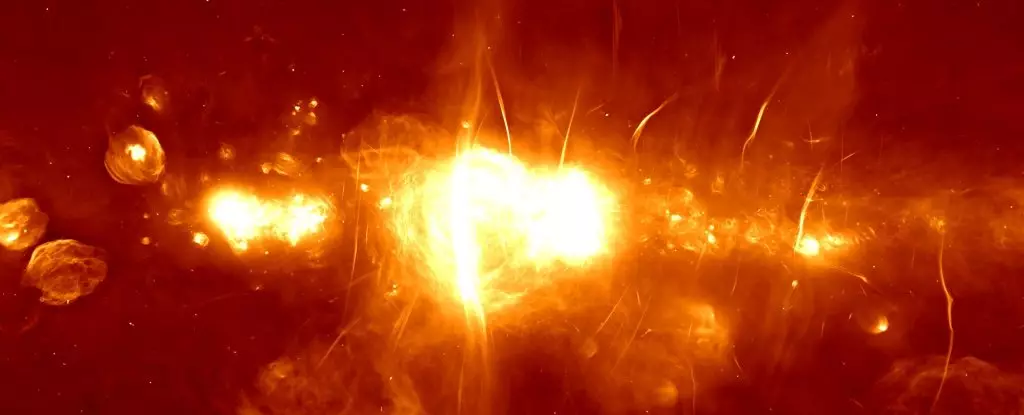The expansive wonders of our galaxy continue to captivate the imagination of scientists and the general public alike. At the very heart of it lies the Central Molecular Zone (CMZ) — a chaotic region filled with the interplay of gas, dust, and an insatiable supermassive black hole. Recent findings, proposed by a team of astronomers led by Kai Yang from Shanghai Jiao Tong University, introduce an enthralling new concept: slim filaments of gas operating like cosmic tornadoes. These structures, unlike anything previously documented, unveil the dynamic processes taking shape around the Milky Way’s nucleus.
The CMZ: A Dynamic Laboratory of Cosmic Forces
The Central Molecular Zone is anything but mundane. Spanning approximately 2,000 light-years, this dense region offers a remarkable habitat for complex molecular interactions. The CMZ houses an astonishing 80% of the dense gas in our galaxy and about 5% of its molecular gas. Within this cauldron of cosmic ingredients, clouds of gas and dust whirl about at dizzying speeds — up to 100 kilometers per second. The environment is bred for violence, featuring shock fronts and the tumult of molecules constantly forming and disintegrating.
Despite the tumult, understanding the CMZ’s dynamics presents formidable challenges. Its density obscures our observational capabilities, making it difficult to probe into the very heart of this cosmic maelstrom. Utilizing the advanced Atacama Large Millimeter/submillimeter Array (ALMA) in Chile, Yang and his team sought to map the unseen behaviors of gases — particularly looking for silicon monoxide, a frequent marker of molecular interactions. Instead of the expected outcomes, they stumbled upon a new phenomenon that would redefine our understanding of this tumultuous area.
Introducing Slim Filaments: Cosmic Signposts of Turbulence
Through meticulous examination, the researchers uncovered these newly identified “slim filaments,” which consist of long, narrow strands of gas. These filaments were detected at an extremely refined scale, an astonishing feat that led to the realization that they differ significantly from previously known gas structures. Interestingly, the slim filaments were found to be spatially offset from star-forming regions, proving to be a puzzling aspect of their nature. This unexpected revelation illuminated the potential mechanisms by which gas is dispersed within the CMZ.
Further analysis revealed that these filaments are not merely simple entities; they encompass complex organic molecules such as formaldehyde, methanol, and acetonitrile. Their velocity patterns are also unlike those found in other gas filaments, indicating a predominance of turbulent pressure which bolsters their comparison to tornadoes. The implications of such findings suggest that these structures may engage in significant material circulation, contributing to the dynamic ecosystem of stars forming in the CMZ.
A New Understanding of Galactic Recycling
The genesis of these slim filaments remains elusive, but the researchers speculate that shock events within the CMZ may play a vital role. Violent collisions in this chaotic environment likely produce turbulence, heating molecules to the gaseous state before releasing them into the wider interstellar medium. As these gases cool, they condense back into dust, continually feeding into the CMZ’s material replenishment.
The potentially abundant presence of these slim filaments throughout the CMZ could offer a fresh perspective on the region’s recycling mechanisms. The continuous cycle of gas and dust not only sustains the CMZ but also contributes significantly to the formation of star systems. This revelation allows astronomers to posit that slim filaments constitute a distinct class of structures, diverging from conventional dense gas filaments and highlighting the complexities of interstellar interactions.
Implications for the Cosmic Landscape
The identification of slim filaments provides a groundbreaking insight into the turbulence and complexity inherent in one of the Milky Way’s most chaotic environments. They are not merely passive structures; rather, they act as conduits in a vast cosmic network, redistributing material and contributing to the galaxy’s ongoing processes of formation and destruction. Such newfound knowledge has profound implications — not just for our comprehension of the Milky Way but for our understanding of galactic formation and evolution at large.
The work spearheaded by Yang and his team demonstrates the need for continued exploration and study of cosmic phenomena. Each discovery opens the door to deeper comprehension and sparks curiosity to investigate the uncharted realms of our universe. As we unveil the secrets of the CMZ, we gain invaluable insights into the life cycles of stars, the behavior of gases in turbulent environments, and the very fabric of the universe itself. The journey to understanding is, undoubtedly, as thrilling as the mysteries we seek to unlock.


Leave a Reply